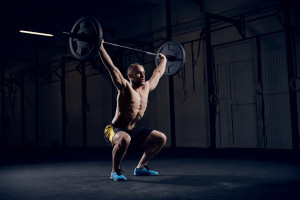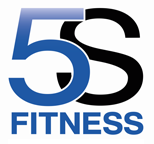 Hi, I thought it was time to jump on the bandwagon and write an article about “Crossfit”… I’ll start off by giving a short spiel of my overall views on Crossfit, but what I really want to discuss is how Crossfit incorporates Olympic Lifting into its “WOD’s” (“Workout of the day” – Posted to the Crossfit website, but often used by Crossfitter’s to refer to any Crossfit workout they are doing)
Hi, I thought it was time to jump on the bandwagon and write an article about “Crossfit”… I’ll start off by giving a short spiel of my overall views on Crossfit, but what I really want to discuss is how Crossfit incorporates Olympic Lifting into its “WOD’s” (“Workout of the day” – Posted to the Crossfit website, but often used by Crossfitter’s to refer to any Crossfit workout they are doing)
Just like any training regime, Crossfit has its Pros & Cons and as a result of it implementing a lot of advanced lifting techniques done at high rep ranges and often at maximal intensity, it has come under a lot of scrutiny.
I myself am not a “Crossfitter” but I have spent a lot of time working/training with Crossfitter’s in Crossfit “Boxes” (A Crossfit Facility/Gym) and other gym environments. Although I have not fully embraced the Crossfit ethos with open arms, I am hugely grateful for all Crossfit has done for the fitness industry… Regardless of its flaws (If you agree they are flaws) Crossfit has brought a higher level of training to the masses. Whether that level of training is always put across to the standard it should be is debatable, but nether the less incorporating Olympic lifts, Powerlifts, Gymnastics and High Intensity Training (To name a few) into a single training system has definitely opened peoples eyes to the broadness of physical training and just how far the human body can push itself… Crossfit has basically put “Barbell Training” and the concept of intense, varied training on the Map!
Its key to remember that physical training can always be contraindicated (Not advised) in some way… Physical training after all is about stressing the systems of the body to the point at which they are stimulated to adapt and improve… Its up to the individual to decide whether the stresses placed on the body are worth the rewards of the exercise. These rewards are not always aesthetic or performance based, but are often also based upon enjoyment value and personal accomplishment… Arguably an office worker might not have any real use for leaning how to Olympic lift, but might find huge satisfaction in reaching a PB Snatch… There are always different opinions on the best methods of achieving a goal, but its ultimately up to the individual to take on the method that is right for them.
So with all this in mind, why does Crossfit come under “so much” fire?
In my opinion the most notable aspect of Crossfit is definitely the way in which they implement Olympic lifts into the WOD’s… And for us to really understand the pros and cons of this, we first have to look at Olympic Lifting in itself.
Olympic lifting is an athletic discipline where the athlete will attempt a “Single” maximal lift of a barbell with bumper plates (Weights plates).
There are two styles of lift:
- The Snatch – A single movement lift from the floor to an extended overhead position.
- The Clean & Jerk – A two movement lift from the floor to the shoulder position and them from the shoulders to an extended overhead position.
In Olympic lifting the athlete receives 3 attempts in each lift and the combined total of the two highest successful lifts determines the overall result (In Bodyweight categories).
While there are relatively few competitive Olympic weightlifters (Which has increased since the expansion of Crossfit & Social media etc), Olympic lifting and the breakdowns of the lifts are used massively in the Strength & Conditioning of elite athletes… The explosive nature of the lifts, utilising the body as a whole to develop strength and power correlates directly to sports performance… However due to the complexity involved in these lifts, there are plenty of arguments surrounding the use of Olympic lifting in an athletes training regime… Buts that’s another Article!
So back to Crossfit… When we talk about how Crossfitter’s implement Olympic lifting into their WOD’s, we are talking about high rep Olympic lifting, often done for time and as fast as possible (AMRAP – As many reps as possible)… So what’s the benefits and are they worth the risks?
To answer that question here’s first a quote from Mark Rippetoe (World renowned Strength Coach) explaining the difference between “Exercise” & “Training”:
“Exercise is physical activity for its own sake, a workout done for the effect it produces today, during the workout or right after you’re through. Training is physical activity done with a longer-term goal in mind, the constituent workouts of which are specifically designed to produce that goal.”
Olympic lifting for time is purely and simply “High Risk Exercise” and in my opinion the risks far outweigh the benefits… However if you enjoy the challenge of a Crossfit WOD including Olympic lifts or are competing in a Crossfit comp then who am I to say stop… But here’s the reasoning behind my opinion and there’s only need for these 3 points:
- High rep range Olympic lifting will fatigue the individual, resulting in a deterioration of good form and lifting technique… These are complex lifts and potentially high risk even when performed as a single rep, so adding multiple reps to the equation, often done for time at maximal intensity is simply a recipe for disaster (Spinal Injuries)… Repeating lifts with less that ideal form will also reinforce poor motor patterns and technique.
- If you are doing high rep Olympic lifting for strength gains… Then you misunderstand the basic principles of developing strength effectively… High rep compound lifts = Metabolic Conditioning not Strength Training!
- If you are doing high rep Olympic lifting for conditioning… Then you’ve chosen an exercise far too complex for your needs… Go push a sledge or use some battle ropes!
Basically if your “High Rep Olympic Lifting” Its because you enjoy it! So if your happy with the risks involved, then go right ahead… But do us a favour… Go see a qualified Olympic lifting coach and drill the basics first!
